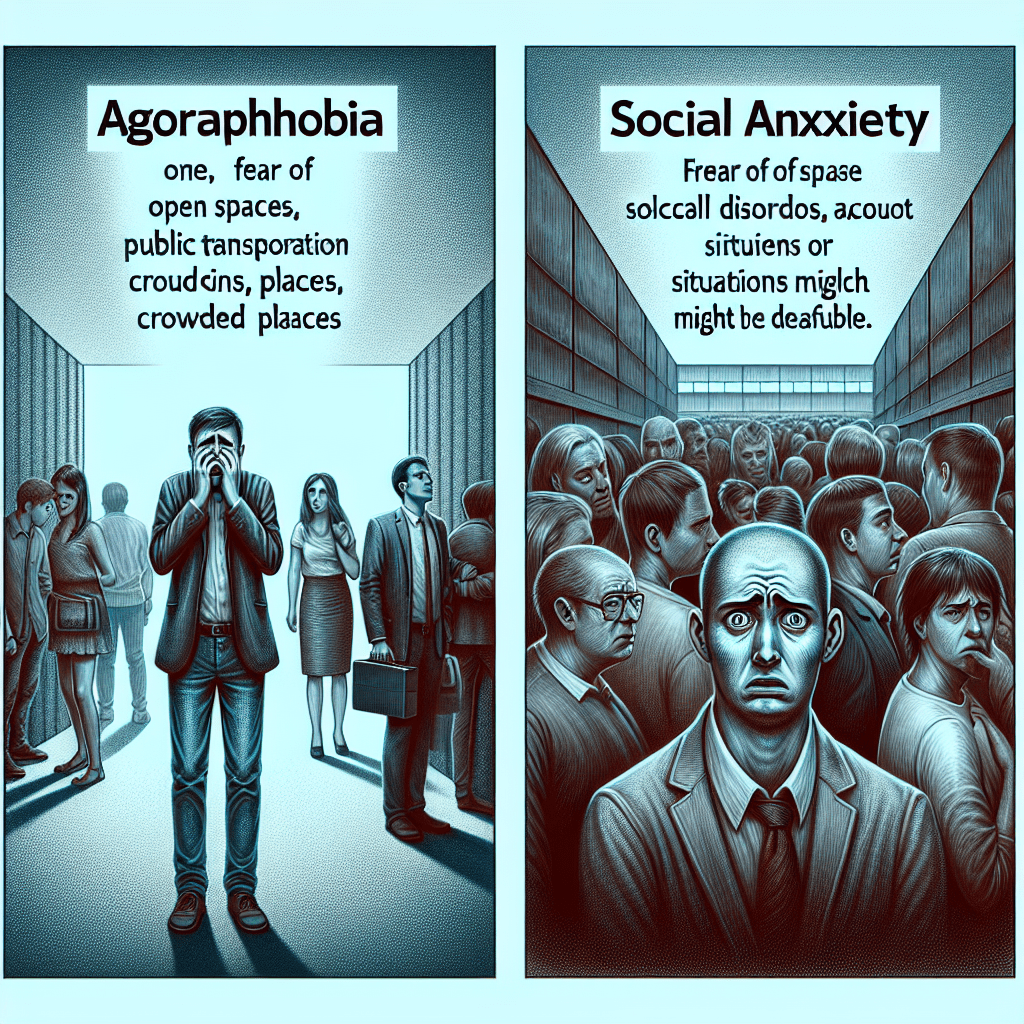-
Table of Contents
What is the Difference Between Agoraphobia and Social Anxiety Disorder?
When it comes to mental health disorders, it is important to understand the distinctions between different conditions. Agoraphobia and social anxiety disorder are two commonly misunderstood conditions that can significantly impact a person’s life. While they share some similarities, they also have distinct characteristics that set them apart. In this article, we will explore the differences between agoraphobia and social anxiety disorder, including their symptoms, causes, and treatment options.
Symptoms of Agoraphobia
Agoraphobia is an anxiety disorder characterized by a fear of being in situations where escape might be difficult or embarrassing. People with agoraphobia often avoid places or situations that they perceive as unsafe or where they have previously experienced panic attacks. Some common symptoms of agoraphobia include:
- Intense fear or anxiety about being in public places or situations
- Avoidance of crowded places, open spaces, or situations that may trigger panic attacks
- Feeling trapped or helpless in certain situations
- Dependency on a trusted companion to feel safe outside the home
- Physical symptoms such as rapid heartbeat, sweating, trembling, or shortness of breath
It is important to note that agoraphobia is not simply a fear of leaving the house. It is a complex condition that involves a fear of specific situations or places where escape may be difficult or embarrassing.
Symptoms of Social Anxiety Disorder
Social anxiety disorder, also known as social phobia, is characterized by an intense fear of social situations. People with social anxiety disorder often fear being judged, embarrassed, or humiliated in social settings. Some common symptoms of social anxiety disorder include:
- Extreme fear or anxiety in social situations, such as public speaking or meeting new people
- Avoidance of social situations or enduring them with intense distress
- Worrying excessively about embarrassing oneself or being negatively evaluated by others
- Physical symptoms such as blushing, sweating, trembling, or nausea
- Difficulty making eye contact or speaking in front of others
Unlike agoraphobia, social anxiety disorder specifically revolves around social situations and the fear of negative evaluation by others. It is not limited to specific places or situations like agoraphobia.
Causes of Agoraphobia
The exact cause of agoraphobia is unknown, but it is believed to be a combination of genetic, environmental, and psychological factors. Some potential causes and risk factors for agoraphobia include:
- A history of panic attacks or other anxiety disorders
- A family history of agoraphobia or other anxiety disorders
- Experiencing a traumatic event, such as a car accident or physical assault
- Having a tendency to be more anxious or fearful in general
- Having a history of childhood abuse or neglect
It is important to note that not everyone with these risk factors will develop agoraphobia, and some individuals may develop the condition without any known risk factors.
Causes of Social Anxiety Disorder
Like agoraphobia, the exact cause of social anxiety disorder is not fully understood. However, several factors may contribute to the development of social anxiety disorder, including:
- Genetic predisposition: Research suggests that there may be a genetic component to social anxiety disorder, as it tends to run in families.
- Environmental factors: Traumatic experiences, such as bullying or humiliation, can contribute to the development of social anxiety disorder.
- Brain structure and function: Some studies have found differences in the brain structure and function of individuals with social anxiety disorder, suggesting a biological basis for the condition.
- Learned behavior: Observing others’ anxious or avoidant behavior in social situations can influence the development of social anxiety disorder.
It is important to note that social anxiety disorder can develop in individuals without any known risk factors, and not everyone with risk factors will develop the condition.
Treatment Options for Agoraphobia
Treating agoraphobia typically involves a combination of therapy and medication. Some common treatment options for agoraphobia include:
- Cognitive-behavioral therapy (CBT): CBT helps individuals identify and change negative thought patterns and behaviors associated with agoraphobia. It also includes exposure therapy, where individuals gradually face their fears in a controlled and supportive environment.
- Medication: Antidepressant and anti-anxiety medications may be prescribed to help manage the symptoms of agoraphobia. These medications can help reduce anxiety and panic attacks.
- Support groups: Joining support groups can provide individuals with agoraphobia a sense of community and understanding. Sharing experiences and coping strategies with others who have similar challenges can be beneficial.
Treatment Options for Social Anxiety Disorder
Similar to agoraphobia, the treatment of social anxiety disorder often involves a combination of therapy and medication. Some common treatment options for social anxiety disorder include:
- Cognitive-behavioral therapy (CBT): CBT is highly effective in treating social anxiety disorder. It helps individuals identify and challenge negative thoughts and beliefs about themselves in social situations. Exposure therapy is also commonly used to gradually expose individuals to feared social situations.
- Medication: Selective serotonin reuptake inhibitors (SSRIs) and benzodiazepines are commonly prescribed to help manage the symptoms of social anxiety disorder. These medications can help reduce anxiety and improve overall well-being.
- Social skills training: Learning and practicing social skills can help individuals with social anxiety disorder feel more confident and comfortable in social situations. This may involve role-playing, assertiveness training, and communication exercises.
Summary
In summary, while agoraphobia and social anxiety disorder share some similarities, they are distinct conditions with different symptoms, causes, and treatment options. Agoraphobia is characterized by a fear of specific places or situations where escape may be difficult or embarrassing, while social anxiety disorder revolves around an intense fear of social situations and the fear of negative evaluation by others. Understanding these differences is crucial for accurate diagnosis and effective treatment. If you or someone you know is experiencing symptoms of either condition, it is important to seek professional help for proper evaluation and support.
Also Read-
what is the difference between agoraphobia and social anxiety disorder
which of the following is not an example of social anxiety disorder?
What causes social anxiety disorder?
what lifestyle choices can help reduce the risk of suicide?
What Celebrities Have Social Anxiety Disorder?

